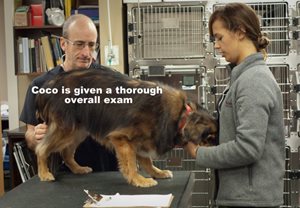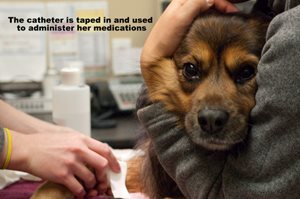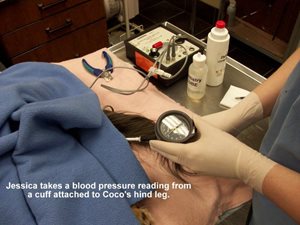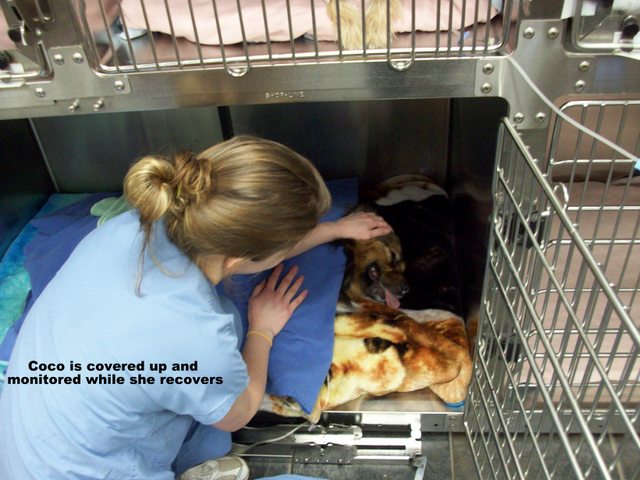Almost every pet receives an anesthetic at least once in its lifetime. Whether as a puppy or kitten is to be spayed or neutered or later in life due to an injury or illness; the thought of having your cherished companion under a general anesthetic can be worrisome for many pet owners.
Just as in human medicine, being fearful of sedation or a general anesthetic for our pets is a very legitimate concern. There are always risks with any anesthesia, be it for a major surgery or a quick wound repair. However, these risks can be significantly minimized with proper planning, procedure, monitoring and aftercare.
Anesthesia protocols will vary pet to pet, as no two are alike! At Van Isle Veterinary Hospital, your veterinarian will customize your pet’s anesthesia protocol to make sure it meets the needs of that specific individual and these variances will be determined by age, breed, health at the time of surgery and the procedure itself.

What is a General Anesthesia and how risky is it?
A general anesthetic is the administration of drugs to achieve a medically induced state of unconsciousness. During an anesthetic, your pet will be given multiple agents to not only maintain unconsciousness (thus being unable to move) but to also control pain. Sometimes we use what is called a “local” anesthesia which only numbs a specific area or part of the body. In these cases, your pet will also be sedated as well as given pain control. Pet owners are often surprised to learn that in many cases, for senior pets, a general anesthetic is often safer and can have fewer risks than using a heavy sedation and local anesthetic for a procedure.


Why does my pet need to be fasted prior to anesthesia?
We ask that you please ensure your pet has had no food at least 8 – 12 hrs prior to anesthesia for several reasons. The main being for safety! Just like humans, some of the agents we use to sedate or induce your pet can cause them to feel nauseous and sometimes they may vomit. When this happens during an anesthetic, animals are unconscious and do not have their natural reflexes to clear their own throat or “wind pipe”. There is a high risk of pneumonia, known as “aspiration pneumonia” due to food particles/material entering the airway. There is also a risk of damage to the esophagus from stomach acid entering the “food pipe”. Both of these scenarios can be very serious. By fasting, your helping to ensure this does not happen. This is why we will always ask you when your pet’s last meal was upon admitting to the hospital. We completely understand that pets manage to get into all sorts of things or sneak treats when we are not looking. Don’t be shy or embarrassed to admit if your pet may have eaten. We are very aware these things happen and would rather know ahead of time to avoid any unnecessary risks.
What happens after I leave my pet with you in the morning?
After completing our admit form with one of our technicians or receptionists (which lists any current medications, known allergies, last known meal and your emergency contact info) and answering all of your questions, your pet will be taken into our treatment. This is where a blood sample will be obtained prior to sedation. Your veterinarian will also do another, thorough pre-anesthetic physical exam, even if your pet has recently been seen. Once the pre-anesthetic blood work is finished and your pet’s physical exam is complete, your veterinarian will come up with an individual anesthetic protocol and treatment plan with the surgery technician. A mild sedative is given (which also contains pain control) and then your pet will be admitted to his or her own kennel which will be their kennel during their hospital stay. All of our kennels have a padded foamy, blankets and even warming bottles to keep your pet warm and snug during their stay!
Sedation usually takes approx. 20 – 30 minutes before they are calm, quiet and sleepy. Once optimum sedation is achieved, your pet will then be brought back out to our treatment area to begin surgery prep. Your pet is assigned a registered veterinary technician who will be working with your pet’s veterinarian that day. She will then place a catheter into a vein on your pet’s front leg to administer IV fluids during the procedure as well as during the recovery period. IV fluids are used to maintain optimum blood pressure, replace electrolytes and to keep your pet hydrated. Once the IV fluids are running, an induction medication is given making them sleepy enough to place an endotracheal tube for breathing as well as to maintain and control the Isoflurane anesthetic. The second source of pain control is also given around this time. Now your pet is completely unconscious, pain-free and ready for surgery.
What does it mean to “prep” for surgery?
While under anesthetic the technician will begin surgery prep which includes placing a lubricant into the eyes to keep them moist, placing an identifying tattoo or microchip when applicable, trim nails, clip the hair around the surgical site and scrub the surgical site at least 3 times. The patient is then moved into the surgery suite where the veterinarian is scrubbed, gowned and waiting to begin. Your pet will be placed on a circulating water heat pad with blankets to help maintain ideal body temperature and we sometimes put little socks on your pet’s feet to hold in the heat!
The veterinary technician remains with your pet during the entire anesthetic and will regularly record your pet’s vitals, monitors, for any signs of change and assists the vet during surgery. We monitor anesthetic depth, oxygen level, heart rate, breathing rate, blood pressure and temperature.

Where will my pet go when surgery is finished?
When surgery is finished, the anesthetic gas is turned off while the oxygen is still running to ensure proper oxygenation prior to moving into the recovery room. This is especially important in some breeds such as French Bull Dogs and Pugs who have a short snout and often have a more difficult time breathing. The technician takes another reading of your pet’s vitals, the surgical site is cleaned you’re your pet is moved to a recovery kennel in the main treatment room so they can be monitored closely. A veterinary technician or assistant will remain at your pet’s beside until the endotracheal tube can safely be removed. Once able to lift his own head, a blanket and warming bottle is placed in their kennel and will remain in the main treatment room for approx. 30mins – 1 hr before being moved back into their comfy bed in one of the patient wards. IV fluids are maintained for approx. 2 – 4 hrs post-surgery.
As soon as your pet is in the recovery room, they are taken out for a little walk and bathroom break. We will call owners to let them know how the surgery went and to give an appropriate go-home time as soon as they are ready to be moved into their recovery kennel. All of your pet’s medications and after care instructions will be reviewed with you in person when your pet is ready to be picked up.

Written by Van Isle Veterinary Hospital